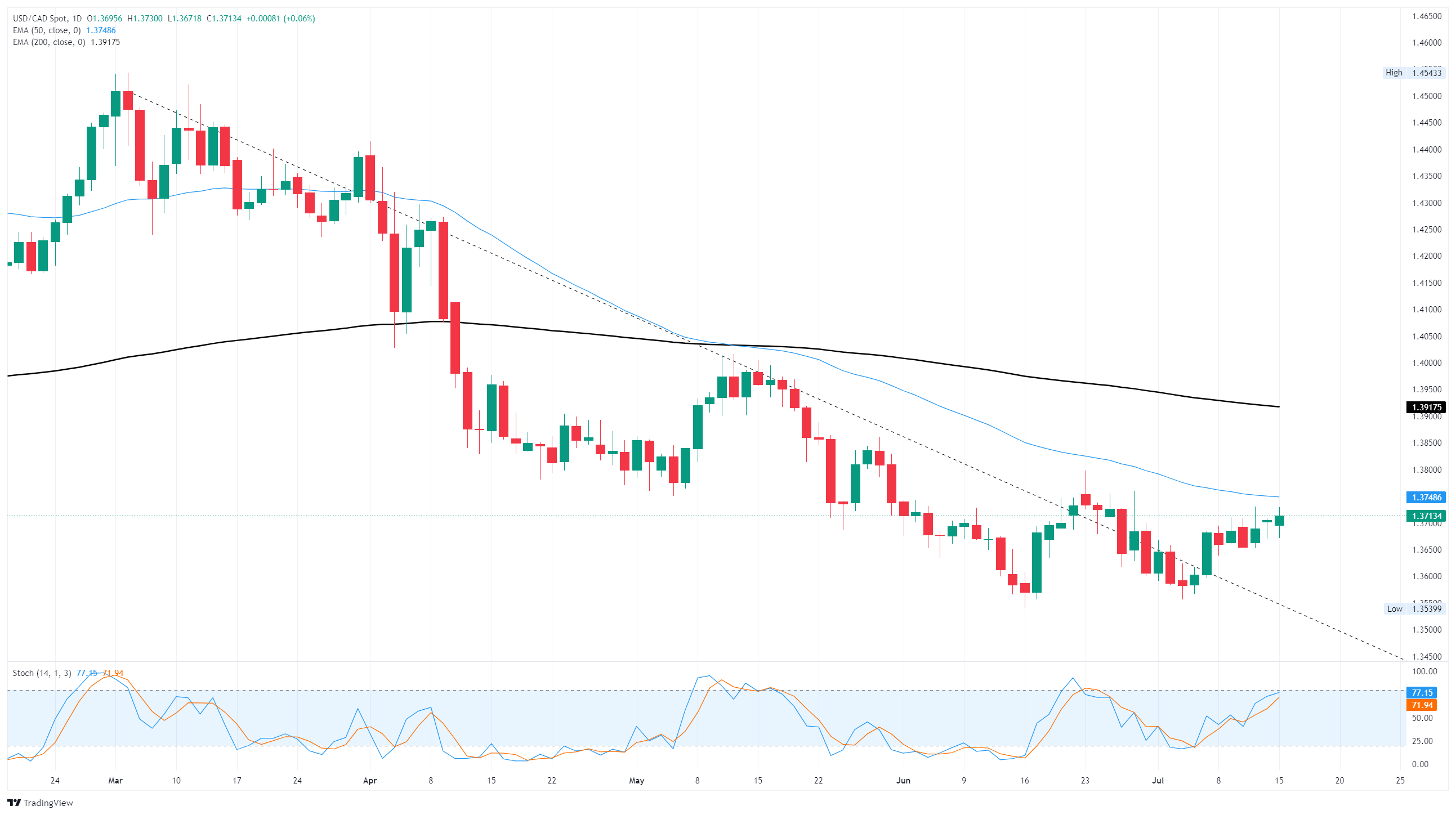Canadian Dollar slumps after CPI inflation double-header prints higher in June
- The Canadian Dollar took a double hit on Tuesday on the back of rising inflation pressures.
- CPI inflation metrics kicked higher in both the US and Canada in June.
- Odds of Fed rate cuts sank post-CPI, bolstering the Greenback and pushing the Loonie into familiar lows.
The Canadian Dollar (CAD) took a one-two punch on Tuesday after Consumer Price Index (CPI) inflation figures rose through the end of the second quarter on both sides of the 49th parallel. The Loonie fell back into recent lows post-CPI print, boosting the USD/CAD pair back above the 1.3700 handle.
Canada and the United States (US) both saw price pressures increase in June, reigniting market fears that central bank rate cuts will get pushed even further out. The Bank of Canada’s (BoC) frenzied pace of interest rate slashes earlier this year looks well and truly over for the time being, and market expectations for a Federal Reserve (Fed) rate cut in September are evaporating.
Daily digest market movers: Canadian Dollar takes an inflation-led hit
- The Canadian Dollar fell four-tenths of one percent top-to-bottom against the US Dollar on Tuesday.
- Safe-haven flows into the Greenback have bolstered the USD across the board, and CAD bulls are slowly losing control of price action.
- Canadian annualized CPI inflation rose to 2.7% YoY versus the previous 2.5%.
- Core Canadian CPI inflation also accelerated to 1.9% YoY versus 1.7%.
- US CPI for the year ended in June rose to 2.7% from 2.4%, pushing market rate cut hopes to the floor.
- Rate traders are still holding out hope, but hope is dying on the vine: according to the CME’s FedWatch Tool, rate markets only see around 55% odds of at least a 25-basis-point rate trim on September 17.
Canadian Dollar price forecast
The Canadian Dollar is poised to roll over into a fresh bearish cycle as Loonie traders run out of buying runway. The Loonie topped out near 1.3570 against the Greenback, and the USD/CAD looks set for a fresh bullish push into the high end. The pair is still trading below the 200-day and 50-day Exponential Moving Averages (EMAs) as the US Dollar pulls itself up from the floor, but technical momentum is poised to push USD/CAD higher.
USD/CAD daily chart

Canadian Dollar FAQs
The key factors driving the Canadian Dollar (CAD) are the level of interest rates set by the Bank of Canada (BoC), the price of Oil, Canada’s largest export, the health of its economy, inflation and the Trade Balance, which is the difference between the value of Canada’s exports versus its imports. Other factors include market sentiment – whether investors are taking on more risky assets (risk-on) or seeking safe-havens (risk-off) – with risk-on being CAD-positive. As its largest trading partner, the health of the US economy is also a key factor influencing the Canadian Dollar.
The Bank of Canada (BoC) has a significant influence on the Canadian Dollar by setting the level of interest rates that banks can lend to one another. This influences the level of interest rates for everyone. The main goal of the BoC is to maintain inflation at 1-3% by adjusting interest rates up or down. Relatively higher interest rates tend to be positive for the CAD. The Bank of Canada can also use quantitative easing and tightening to influence credit conditions, with the former CAD-negative and the latter CAD-positive.
The price of Oil is a key factor impacting the value of the Canadian Dollar. Petroleum is Canada’s biggest export, so Oil price tends to have an immediate impact on the CAD value. Generally, if Oil price rises CAD also goes up, as aggregate demand for the currency increases. The opposite is the case if the price of Oil falls. Higher Oil prices also tend to result in a greater likelihood of a positive Trade Balance, which is also supportive of the CAD.
While inflation had always traditionally been thought of as a negative factor for a currency since it lowers the value of money, the opposite has actually been the case in modern times with the relaxation of cross-border capital controls. Higher inflation tends to lead central banks to put up interest rates which attracts more capital inflows from global investors seeking a lucrative place to keep their money. This increases demand for the local currency, which in Canada’s case is the Canadian Dollar.
Macroeconomic data releases gauge the health of the economy and can have an impact on the Canadian Dollar. Indicators such as GDP, Manufacturing and Services PMIs, employment, and consumer sentiment surveys can all influence the direction of the CAD. A strong economy is good for the Canadian Dollar. Not only does it attract more foreign investment but it may encourage the Bank of Canada to put up interest rates, leading to a stronger currency. If economic data is weak, however, the CAD is likely to fall.

